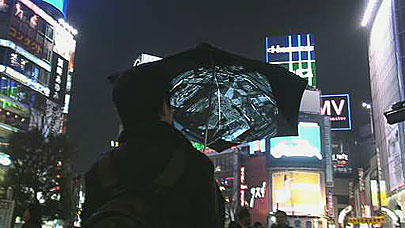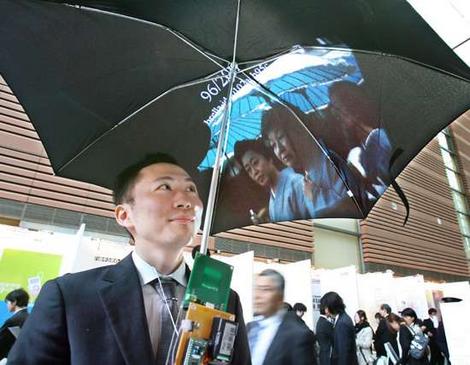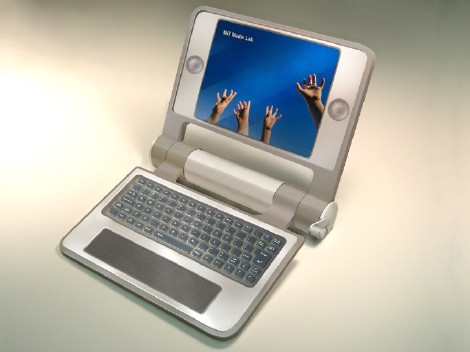|
|
|||||||||||||||||||||||||||||||
|
Umbrella TVs
The umbrella as computer screen June 3rd 2007. The number one song purchased last week on the iTunes Music Store was R&B singer Rihanna's "Umbrella." Wouldn't it be ironic if you could download her song using... an umbrella? It's a not-too-far fetched prospect, given a couple of Japanese researchers' brainy idea to come up with, yes, the Internet umbrella. Perhaps it was bound to happen. Our cellphones can access the Internet. Ditto some refrigerators. So, Takashi Matsumoto and Sho Hashimoto decided the umbrella was the next frontier. In some ways it heralds the manner in which we will interact with the Internet in the real world instead of just on a screen, transforming it, as one scholar puts it, from cyberspace to cyber "place." It also, however, begs the question: at what point does technology become useless? "The umbrella is like an everyday object for us; we wanted to make it more precious," explains Matsumoto in an interview from Tokyo. "So we added some functions to make rainy days fun." The goal for Matsumoto, a Ph.D. candidate in media design at Keio University, was not to create technology in the traditional sense, with screens and touchpads. "Our design approach is completely opposite, creating new social user interactions first." The umbrella is outfitted with a projector that beams an image on the underside of the canopy. Currently it's a bulky contraption that accesses the Internet using a laptop to dial into a cellphone network (wireless, or Wi-Fi, connections come and go as you walk around, making them unreliable). But in the future the umbrella will access the Internet itself, like a cellphone.
It has two major functions. It comes with a global positioning device, so Google Earth can show you a hovering image of where you are in the city, allowing you to orient yourself using landmarks. It also has a camera, and the photos are automatically uploaded to Flickr, the wildly popular photo sharing website, and projected back to the umbrella. You can scroll through photos with a wrist-snap of the shaft. "We have a lot of experiences on a rainy day in the city but no way to share them," Matsumoto says. "So we're focusing on the social sharing functions." Is this really necessary? you may ask. Is this an instance where useful technologies Ð umbrella, projector, the Internet Ð when combined, become useless? Joshua Barker, who teaches and researches the anthropology of new technologies at the University of Toronto, would say yes. "I think, at least at this stage, you can think of it as a novelty item," Barker says, who traces the ways in which new technologies are introduced to and affect societies. "On the one hand, there's a point at which old technologies become obsolescent, from VHS to 8-track. But this may be a product that never gets off the ground." The umbrella as screen may not have much hope. "For a long time, the producers of TV screens and computer monitors have been trying to colonize different spaces. One of the biggest is the kitchen, and so far they've been unsuccessful." The umbrella reflects however, a coming collision between the online world and the real one. "It's the Internet as cyberspace, to the Internet as cyber place," Barker says. Simply walking along the street will be like searching the Internet. For instance, a device, even an umbrella, could carry not just a 3-D map of where you are, but also all the information you have about the area from the Internet. You could call up information on restaurants, for example, or history. Alternatively, it could lead to common Internet actions, such as downloading music, taking place on non-traditional devices. Indeed, Matsumoto's field of research is called "ubiquitous computing." Matsumoto says that for now, they're trying to keep the device simple. The next step is to geographically "tag" photos in Flickr, so that pictures of the area you're in would be displayed on the umbrella. So if someone was there before and found a great eatery, that would pop up. Barker sees another function of the umbrella: yet another space for advertising. Matsumoto also sees the possibility, but claims that his invention will only be a carrier. Google Earth might house ads from businesses that would show up in a 3-D map, he says. He says thinking about the Internet umbrella in terms of necessity is a red herring. "We hope it will change our behaviour on a rainy day," he says. "We believe people of the Internet generation have a lot of motivation to do this kind of content-creation and social-sharing activity." To that end, he hopes a company will take his idea and run with it. So far no takers. But people on the streets are interested. A video on Matsumoto's web site shows him walking about Tokyo as pedestrians stop and gawk at his umbrella. Together, they point out buildings they see in front of them but also on the umbrella. After the typical oohs and aahs, one young woman sums it up best: "I see!," she says, "if I get lost in the rain, I will know where it is!" New and Improved?
|
|
||||||||||||||||||||||||||||||
|
Website Design + SEO by designSEO.ca ~ Owned + Edited by Suzanne MacNevin | |||||||||||||||||||||||||||||||


